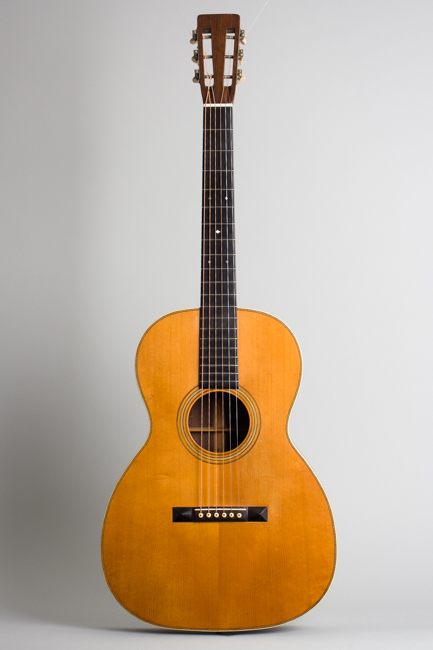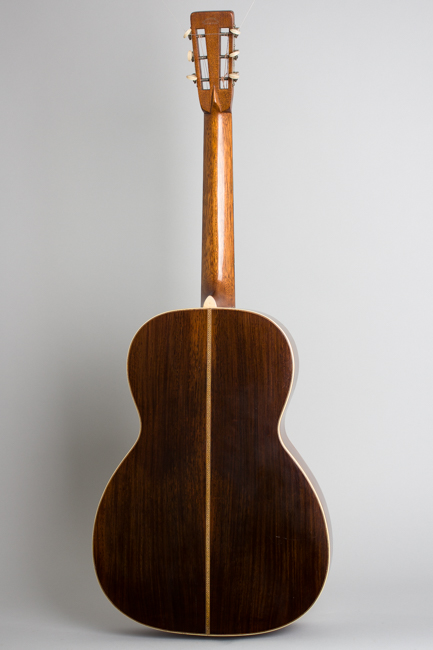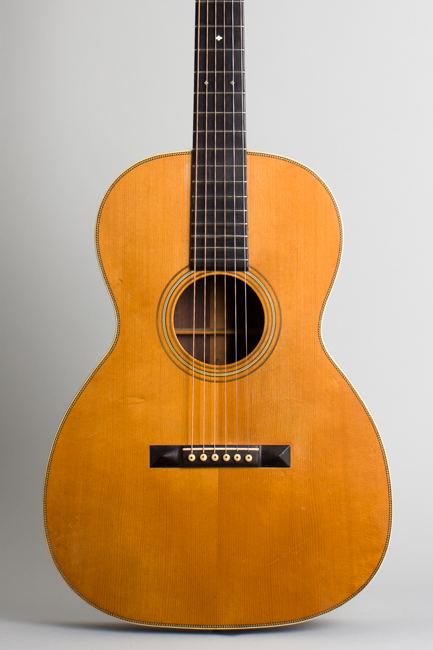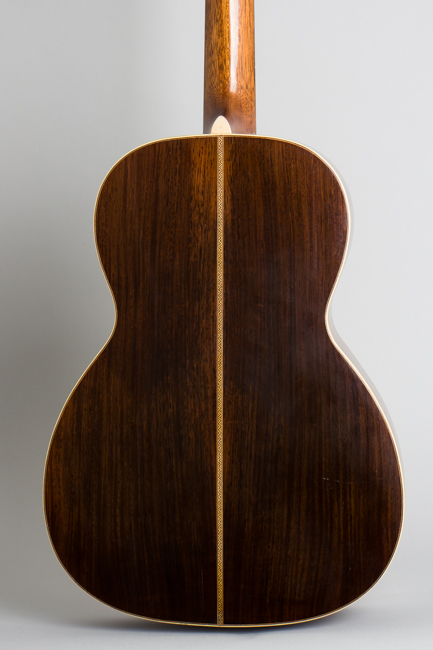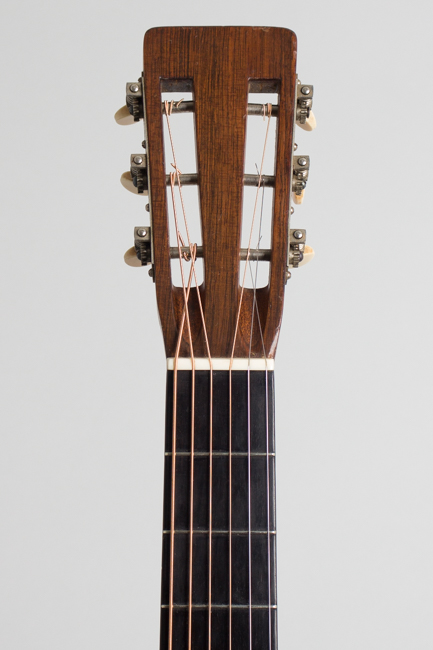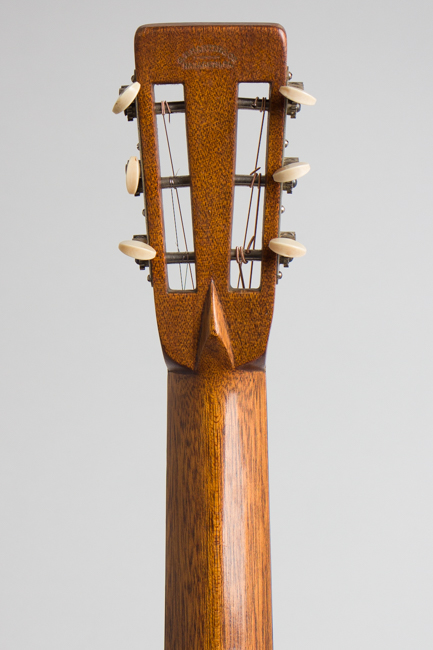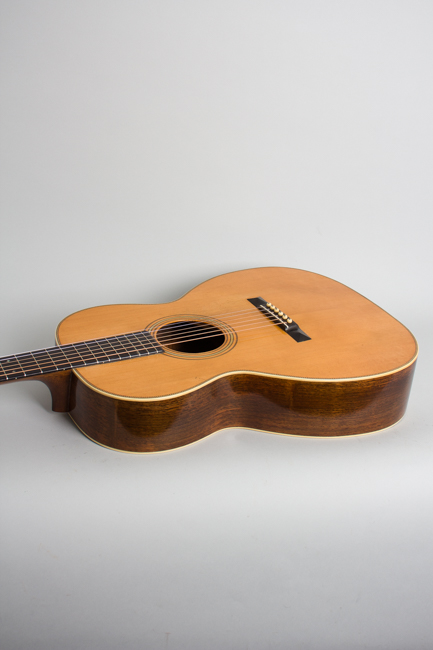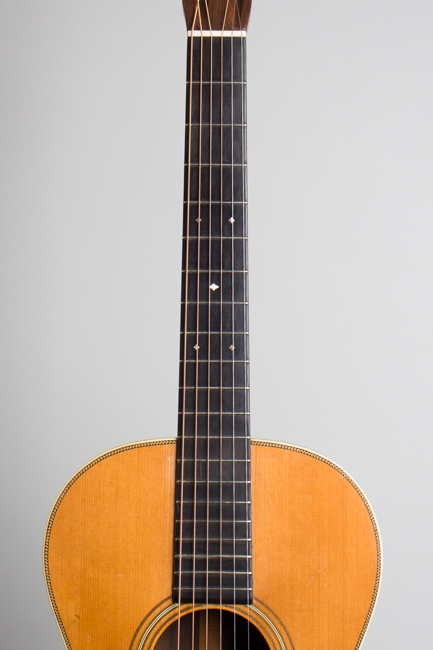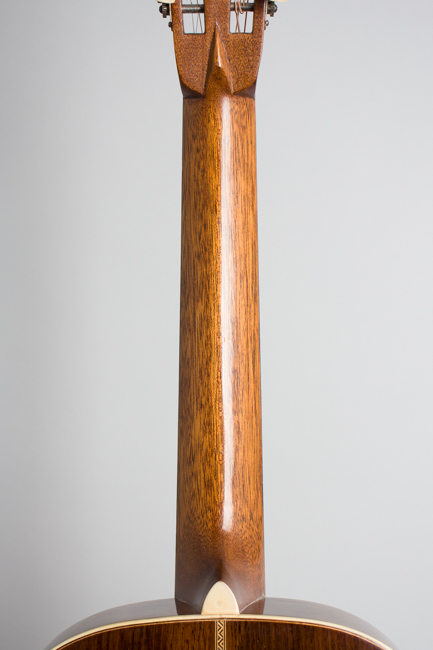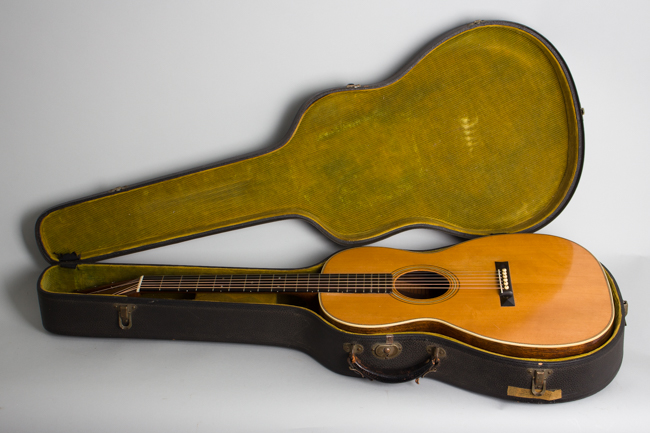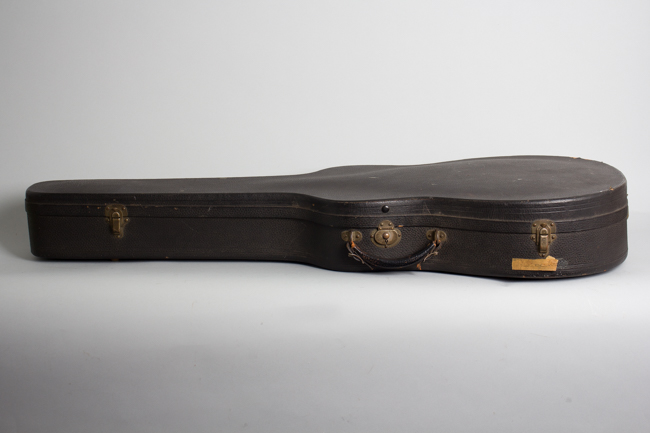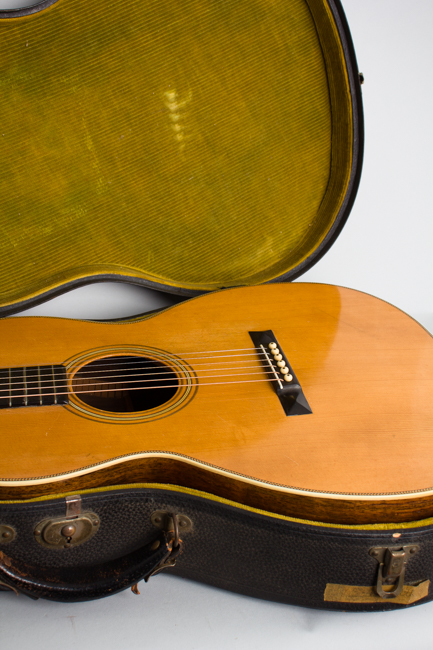C. F. Martin 000-28 Flat Top Acoustic Guitar (1925)
This item has been sold.
Item # 11389
Prices subject to change without notice.
C. F. Martin 000-28 Model Flat Top Acoustic Guitar (1925), made in Nazareth, PA, serial # 22079, natural lacquer finish, Brazilian rosewood back and sides, Apalachian spruce top; mahogany neck with ebony fingerboard, original black hard shell case.
If your fretted tastes run to 12-fret flat tops, this 1925 000-28 may be about as close to the perfect guitar as has ever been made. It is also a very rare instrument. This model was Martin's largest standard body size at the time, and while it was not the most expensive instrument they offered all above it were built with pearl trim that raised the price point without necessarily making for a better playing or sounding guitar. The Style 28 is bound in ivoroid and bordered with the wood marquetry that has gone down in Martin legend as "herringbone", a defining part of the company mystique.
It was by this point JUST becoming a steel-string guitar, a then brand new development. Through the 1920s Martin gradually transitioned away from their traditional gut stringing, but into the latter years of the decade many of the expensive Brazilian rosewood guitars were still built for gut-strings unless specifically ordered for steel. It was not until 1928 that the 000-28 was officially listed as a steel-string guitar although by then a number had been already built that way, this one among them. The only real difference is *slightly* heavier bracing, with the rear legs of the main "X" and two tone bars behind it still delicately scalloped but a but more meat in the by-the-bridge and forward area.
All materials in this instrument are top grade. The top is beautiful bookmatched Adirondack spruce; the back and sides are lovely straight grained Brazilian rosewood while the mahogany neck is capped with an ebony fingerboard. The neck has a shallow soft "V" profile, while the unbound fingerboard has discreet slotted diamond inlay. The slotted headstock is faced with Brazilian rosewood and mounts early Waverly strip tuners with engraved plates. The back has celluloid trim and a zig-zag wooden backstrip; the soundhole is trimmed with multiple rings of wood and celluloid. The bridge is Martin's traditional pyramid-end slim rectangular ebony piece.
In 1925 the 000-28 had a list price of $80; if that seems laughable today at the time it represented a considerable investment for many players. Still, it was a relative bargain in a professional quality instrument; at the time even a plain pro-grade tenor banjo would run at least $100, and the then-brand new Gibson L-5 archtop listed at $275!
The 15" wide 12-fret 000-28 is a huge sounding guitar then and now, powerful and with plenty of definition even when played hard. While a seemingly obvious choice for period vaudeville, Hawaiian and early "hillbilly" entertainers, this was still a developing market. Only 8 (!) 000-28s were sold in 1925 and even 1929, the peak production year for the 12-fret model, saw all of 82 shipped. The next year sales dropped to practically nothing as the depression set in. Total production of specifically steel-string 12 fret 000-28s cannot be calculated exactly as Martin records do not specify stringing but between 1925 and early 1934 only 267 total examples of the model were sold in total, so by any standard this is a very rare guitar.
The 1929 introduction of the OM-28 with its shortened body and 14-fret neck spelled the end for this "standard" 12-fret model. The new "Orchestra Model" pattern ushered in the era of the modern flat top; by 1934 the "old" 12-fret 000-28 was completely replaced by the 14-fret version for many decades to come. With the light, scalloped early steel-string braced top on the 15 1/4" wide featherweight 12-fret body this is simply a spectacular instrument in every way which responds well to anything from gentle fingerpicking to vigorous flatpicking. It would be the ultimate instrument for a truly authentic 1920s-style band, but really excels in just about any playing style. This is simply a wonderful find, as nice an example of this largest steel-string 12 fret Martin as we have ever had.
Overall length is 39 3/4 in. (101 cm.), 15 1/4 in. (38.7 cm.) wide at lower bout, and 4 1/16 in. (10.3 cm.) in depth at side, taken at the end block. Scale length is 25 1/2 in. (648 mm.). Width of nut is 1 13/16 in. (46 mm.).
Considering its nearly 100 years on earth this is an exceptionally well-preserved guitar. It shows some minor typical wear for its age and far less repair than most. The very thin original finish shows pretty minor dings, dents, and scrapes overall, but less pickwear to the top than most, primarily just to the area below the strings off the rear edge of the soundhole. The finish remains original with none of the overspray often encountered on old Martins, there are very minor touchups to the top here and there. The most notable are to a long scratch below and behind the bridge and a "case lid bite" off the upper waist.
The finish on the back of the neck is almost completely intact with minimal wear; there are just a few shallow dings and dents mostly along the spine. Amazingly for a 90+ year old rosewood Martin there only a couple of very minor crack repairs. One is a small grain split in the lower waist, almost unnoticeable. The other is a longer grain crack on the back off the rear edge just below the center seam, well sealed with some topical touchup.
The ebony bridge is original, the interior of the guitar is very clean including the original very thin maple bridgeplate which is completely intact. The neck has been neatly reset, with minimal marking at the heel. The bar frets appear original; they and the fingerboard show some light wear. The tuners are the correct originals; the screw securing the G-string gear is period but not original.
This is a truly fine-playing guitar, powerful-sounding and extremely articulate even when pushed. We rarely find steel-string Martins of this period that have not had more extensive wear and/or damage; this is not an absolutely pristine guitar, but considering its age and especially rarity is far better preserved than many. It also resides in a beautiful and amazingly solid green corduroy lined original hard shell case, something even rarer than the guitar! Overall Excellent Condition.
If your fretted tastes run to 12-fret flat tops, this 1925 000-28 may be about as close to the perfect guitar as has ever been made. It is also a very rare instrument. This model was Martin's largest standard body size at the time, and while it was not the most expensive instrument they offered all above it were built with pearl trim that raised the price point without necessarily making for a better playing or sounding guitar. The Style 28 is bound in ivoroid and bordered with the wood marquetry that has gone down in Martin legend as "herringbone", a defining part of the company mystique.
It was by this point JUST becoming a steel-string guitar, a then brand new development. Through the 1920s Martin gradually transitioned away from their traditional gut stringing, but into the latter years of the decade many of the expensive Brazilian rosewood guitars were still built for gut-strings unless specifically ordered for steel. It was not until 1928 that the 000-28 was officially listed as a steel-string guitar although by then a number had been already built that way, this one among them. The only real difference is *slightly* heavier bracing, with the rear legs of the main "X" and two tone bars behind it still delicately scalloped but a but more meat in the by-the-bridge and forward area.
All materials in this instrument are top grade. The top is beautiful bookmatched Adirondack spruce; the back and sides are lovely straight grained Brazilian rosewood while the mahogany neck is capped with an ebony fingerboard. The neck has a shallow soft "V" profile, while the unbound fingerboard has discreet slotted diamond inlay. The slotted headstock is faced with Brazilian rosewood and mounts early Waverly strip tuners with engraved plates. The back has celluloid trim and a zig-zag wooden backstrip; the soundhole is trimmed with multiple rings of wood and celluloid. The bridge is Martin's traditional pyramid-end slim rectangular ebony piece.
In 1925 the 000-28 had a list price of $80; if that seems laughable today at the time it represented a considerable investment for many players. Still, it was a relative bargain in a professional quality instrument; at the time even a plain pro-grade tenor banjo would run at least $100, and the then-brand new Gibson L-5 archtop listed at $275!
The 15" wide 12-fret 000-28 is a huge sounding guitar then and now, powerful and with plenty of definition even when played hard. While a seemingly obvious choice for period vaudeville, Hawaiian and early "hillbilly" entertainers, this was still a developing market. Only 8 (!) 000-28s were sold in 1925 and even 1929, the peak production year for the 12-fret model, saw all of 82 shipped. The next year sales dropped to practically nothing as the depression set in. Total production of specifically steel-string 12 fret 000-28s cannot be calculated exactly as Martin records do not specify stringing but between 1925 and early 1934 only 267 total examples of the model were sold in total, so by any standard this is a very rare guitar.
The 1929 introduction of the OM-28 with its shortened body and 14-fret neck spelled the end for this "standard" 12-fret model. The new "Orchestra Model" pattern ushered in the era of the modern flat top; by 1934 the "old" 12-fret 000-28 was completely replaced by the 14-fret version for many decades to come. With the light, scalloped early steel-string braced top on the 15 1/4" wide featherweight 12-fret body this is simply a spectacular instrument in every way which responds well to anything from gentle fingerpicking to vigorous flatpicking. It would be the ultimate instrument for a truly authentic 1920s-style band, but really excels in just about any playing style. This is simply a wonderful find, as nice an example of this largest steel-string 12 fret Martin as we have ever had.
Overall length is 39 3/4 in. (101 cm.), 15 1/4 in. (38.7 cm.) wide at lower bout, and 4 1/16 in. (10.3 cm.) in depth at side, taken at the end block. Scale length is 25 1/2 in. (648 mm.). Width of nut is 1 13/16 in. (46 mm.).
Considering its nearly 100 years on earth this is an exceptionally well-preserved guitar. It shows some minor typical wear for its age and far less repair than most. The very thin original finish shows pretty minor dings, dents, and scrapes overall, but less pickwear to the top than most, primarily just to the area below the strings off the rear edge of the soundhole. The finish remains original with none of the overspray often encountered on old Martins, there are very minor touchups to the top here and there. The most notable are to a long scratch below and behind the bridge and a "case lid bite" off the upper waist.
The finish on the back of the neck is almost completely intact with minimal wear; there are just a few shallow dings and dents mostly along the spine. Amazingly for a 90+ year old rosewood Martin there only a couple of very minor crack repairs. One is a small grain split in the lower waist, almost unnoticeable. The other is a longer grain crack on the back off the rear edge just below the center seam, well sealed with some topical touchup.
The ebony bridge is original, the interior of the guitar is very clean including the original very thin maple bridgeplate which is completely intact. The neck has been neatly reset, with minimal marking at the heel. The bar frets appear original; they and the fingerboard show some light wear. The tuners are the correct originals; the screw securing the G-string gear is period but not original.
This is a truly fine-playing guitar, powerful-sounding and extremely articulate even when pushed. We rarely find steel-string Martins of this period that have not had more extensive wear and/or damage; this is not an absolutely pristine guitar, but considering its age and especially rarity is far better preserved than many. It also resides in a beautiful and amazingly solid green corduroy lined original hard shell case, something even rarer than the guitar! Overall Excellent Condition.
